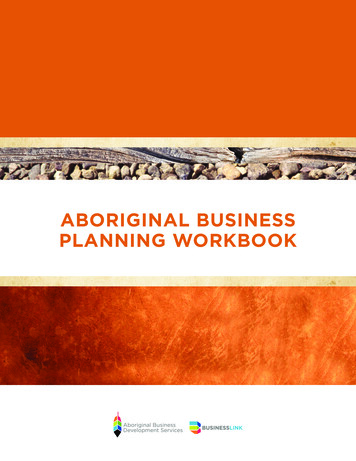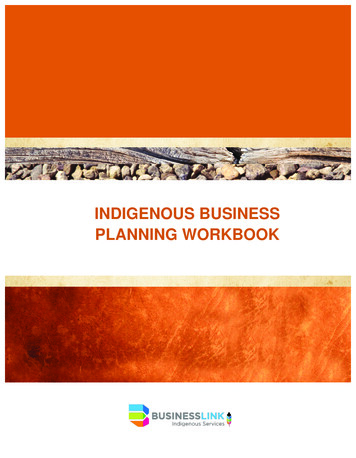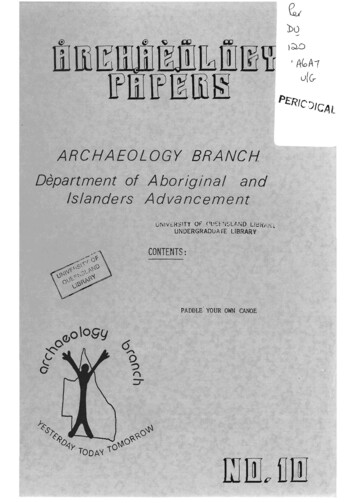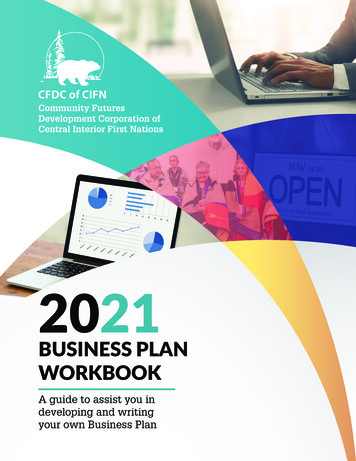
Transcription
ABORIGINAL BUSINESSPLANNING WORKBOOK
CONTENTSForewordHow to use this Business Planning WorkbookResources to Use456STEP 19Finding the right business idea1.1 Finding business ideas91.1.1 Reasons for Starting1.1.2 Idea search methods1.1.3 Idea sources910111.2 Evaluating your idea1.2.11.2.21.2.31.2.41.2.513Business idea screensAdditional information neededIdea assessmentDecision to proceedSkills for running a business13131415161.3 Creating a preliminary vision of your business16STEP 2Learning more about your industry, customersand competitors2.1 Learning about your industry and market2.1.12.1.22.1.32.1.42.1.52.1.6Industry characteristicsIndustry trendsEconomic trendsMarket analysisCommunity trendsEnvironmental considerations2.2 Learning about your customers2.2.1 Customer understanding2.2.2 Target customer characteristics2.3 Analyzing your competition2.3.1 Competitor identification2.3.2 Competitive analysis2.3.3 Resources to useSTEP 3Deciding what the business will do171717181920212223232326262728293.1 Defining the image of your business293.2 Defining in more detail your products and services293.2.13.2.23.2.33.2.4Specific products and services to offerSuppliers of products and servicesProduct and service marginsResources to use30313232Aboriginal Business Planning Workbook1
3.3 Business processes and procedures333.3.1 Manufacturing processes3.3.2 Service processes and procedures3.3.3 Retail processes3333333.4 Considering the distribution of your products and services343.5 Making location decisions353.5.1 Location characteristics3.5.2 Methods to decide on a location3.5.3 Resources to use3536373.6 Setting a pricing strategy373.7 Developing a promotional strategy383.7.1 Promotional techniques and methods to be used3.7.2 Monthly promotional schedule3.7.3 Resources to useSTEP 4Deciding how the business will operate4.1 Establishing human resource requirements4.1.14.1.24.1.34.1.44.1.5Management roles and responsibilitiesStaffing decisionsProfessional supportSummary of salaries, wages and benefitsResources to use4.2 Developing the operational plan4.2.1 Land and buildings4.2.2 Equipment required4.2.3 Contributed assets4.2.4 Furniture and fixtures4.2.5 Communication system4.2.6 Vehicles4.2.7 Insurance coverage4.2.8 Banking charges4.2.9 Bookkeeping and accounting activities4.2.10 Office Supplies4.2.11 Maintenance and repairs4.3 Handling legal requirements4.3.1 Legal structure of the business4.3.2 Regulations and licenses4.3.3 Resources to 15254Aboriginal Business Planning Workbook2
STEP 5Working with Financial Plans555.1 Determining start-up costs555.2 Finding out how many customers you need575.2.1 Fixed costs5.2.2 Variable costs5.2.3 Break-even point5758585.3 Forecasting cash flow595.3.1 Sales forecasting5.3.2 Monthly income and expenses5.3.3 Determining the amount of money you will need to start6061625.4 Creating income statements645.5 Creating balance sheet projections66STEP 669Writing the business plan6.1 Formatting the business plan696.2 Putting the pieces Beginning section (Cover page, Table of Contents)Executive SummaryCompany OverviewMarketing PlanHuman ResourcesOperational PlanFinancial StatementsAppendices6970717275757778Glossary of Terms79Bibliography81Disclaimer:The information presented in this document is intended as a guide only, and while thought to be accurate, is provided strictly "asis" and without warranty of any kind. Business Link, its employees, its directors and members, its agents or contractors will notbe liable to you for any damages, direct or indirect, or lost profits arising out of your use of information provided within thisdocument, or information provided within Business Link's websites.This material may be used, reproduced, stored or transmitted for non-commercial purposes; however, Business Link's copyrightis to be acknowledged. You may not use, reproduce, store or transmit this material for commercial purposes without prior writtenconsent from Business Link. 2015 Business LinkAboriginal Business Planning Workbook3
ForewordBusiness Link is Alberta’s entrepreneurial hub. We are a non-profit organization that helpsAlberta entrepreneurs start their own businesses. We’re a small but mighty team that has apassion for small business.Helping small business owners isn’t new to us – we’ve been doing it since 1996. We wouldn’tbe able to do what we do without the funding support of the Governments of Alberta andCanada.Aboriginal Business Development Services (ABDS) offers specialized support toAboriginal communities and entrepreneurs across Alberta. From startup to expansion, ourresources are tailored to meet the unique needs of our Aboriginal clients. We offer:For Aboriginal entrepreneurs: Personal one-on-one service Informative guidebooks Connections to a network of service providersFor Aboriginal communities (First Nations, Metis, and Inuit): Free small business training delivered in your community Presence at your tradeshows, job fairs, and other entrepreneurial-focused events Complimentary mail-outs of our small business guidebooksThis publication is part of a series of informative guides designed for Aboriginal Albertans inbusiness. To find out more about ABDS services and to request copies of our guides, contactus at:Business LinkBusiness Information Line: 1 800 272-9675Tel: 780 422-7722Fax: 780 422-0055Email: ABDS@businesslink.ca Web Page: www.businesslink.ca/abdsAboriginal Business Development Services (ABDS) is a specialized service ofBusiness Link which is supported by the Governments of Canada and Alberta.Aboriginal Business Planning Workbook4
How to use this Business Planning WorkbookThis Business Planning Workbook is designed to help Aboriginal entrepreneurs create abusiness plan.Business plans are very important tools for people starting a business. A business plan islike a road map. It shows where you want to go and gives the details on how you will getthere.Reasons for creating a business plan are: It helps you decide if your business idea will make a good business It allows you to see potential business problems before you start It identifies the amount and type of financing your business will need It makes it easier for a lender or investor to understand your business idea It increases your understanding of your market, customers, and competitors It helps you make better decisions about your business It improves your ability to manage your business It provides a customized plan for you to refer toThis workbook guides you through the 6 steps from “finding the right business idea” to“writing the business plan.”***It is highly recommended that the following steps be taken one right after another:STEP 1Find the right business idea.STEP 2Learn more about your industry, customers, and competitors.STEP 3Decide what the business will do.STEP 4Decide how the business will operate.STEP 5Work with financial plans.STEP 6Write the business plan.In each step, information is given about the step. Then a series of questions are asked aboutthe business. Some of these questions you will be able to answer directly. For others, youwill probably need to collect additional information to answer them in detail. For some, youwill need to look back at previous answers you have given.When you have finished answering all the numbered questions that apply to your business,you will be able to insert your answers in Step 6 to make a business plan. To help you along,references will be made to resources you might use to answer questions. You will beprovided with examples to guide you.Aboriginal Business Planning Workbook5
To make the most use of this workbook, start at the beginning and work through it page bypage to the end. The answers to the first questions will be used to answer questions thatfollow.RESOURCES TO USEWhere to Do Your ResearchA lot of the information required for the industry and market analysis can be found throughsecondary data sources. This is information that has been gathered by someone else butis relevant to the business you want to start.Examples of sources and types include:AlbertaCanada.comHome Page: www.albertacanada.com/Description: Alberta industry overviews and profiles, economic highlights, small businesshighlights and other statistics and publicationsDirect Link Page: stries.aspxBusiness LinkTel: 1 800 272-9675Home Page: www.businesslink.caDescription: Alberta’s entrepreneurial hub. We offer advice and research, training andwebinars, small business events and Aboriginal Business Development ServicesDirect Link Page: www.businesslink.ca/abdsIndustry CanadaTel: 1 800 328-6189Home Page: www.ic.gc.ca/Description: Industry profiles, company directories, regulations and standards and otherstatistics and publications broken down by industrial categoryDirect Link Page: http://www.ic.gc.ca/eic/site/icgc.nsf/eng/h 07096.html?Open&src mm2#icsub-menuStatistics CanadaTel: 1 800 263-1136Home Page: http://www.statcan.caAboriginal Business Planning Workbook6
Description: Census Profiles (basic Census demographics for Canadian communities,including Aboriginal demographics)Direct Link Page: /dppd/prof/index.cfm?Lang EDescription: Various Aboriginal-specific census data are presented including populationcharacteristics, work, income and spending, and business and financeDirect Link Page: ?pid 10000&lang eng&more 0Additional Resources1. Local public, business, and educational institution libraries Business Link libraryo Euromonitoro FirstResearcho Hooverso PCensuso Reference Canada Trade publications / periodicals / company directories2. Business and industry trade shows and exhibitionsCheck libraries and online for: Show & Exhibitions Directory Trade Show News Network EventsEye3. Magazines and newspapers Check libraries for related topics4. Business professional services, e.g. accountants, lawyers, consultants, insurance brokers,bankers, economic development officers, community groups, or agents Aboriginal Business and Entrepreneurship Development 81 Business Development Bank of Canada www.bdc.ca/ Business Link Ask an Expert services ask-expert-services5. Other business people / known acquaintances / competition I Internet / Business andindustry associations: Métis Nation of Alberta Business Section of TelephoneDirectory Treaty Offices Business Networking Events Chambers of Commerce Band Offices6. Web resources: www.aboriginal.alberta.ca/Aboriginal Business Planning Workbook7
Information on customers can be found through both secondary research and primaryresearch methods. Primary research means gathering specific information about yourbusiness, for example, through a telephone survey.Common primary research techniques include the following:One-on-one interviews are face-to-face discussions with potential customers.Advantages include: Opportunity to get additional, specific information Combines objective (impersonal) and subjective (personal) dataDisadvantages are: Requires more preparation Time-consuming to arrange appointmentsSurveys can be done by telephone, mail and e-mail.Advantages of surveys are: Very objective (impersonal) Responses can be calculated mathematicallyDisadvantages of surveys can be that they are: Inflexible Time consuming to prepareFocus Groups bring together a group of potential customers (8-12 people) to ask themquestions about your proposed business, their buying habits, their perceptions of yourproducts and services.Advantages of using focus groups are: In-depth investigation is possible Can have completely different responses, initiating discussion, which may lead todifferent ideasDisadvantages include: Should be run by a Professional Facilitator Can be costlyOther techniques include: Observation Interview other business owners out of your trading area Interview experts in the field such as professors, retired owners, etc.Aboriginal Business Planning Workbook8
STEP 1Find the right business ideaThe first step in finding the right business for you is to decide why you want to start abusiness and what skills you bring to the business.1.1 Finding business ideas1.1.1 Reasons for startingEntrepreneurs and small business owners have many reasons for starting their businesses.Most successful small businesses have the following primary reasons for starting a business:Common Reasons for Starting a Small Business1) Grab hold of an opportunity2) Fulfill personal objectives3) Fulfill a dream to run a business4) Use experience and skills5) Be your own boss6) Make a living7) Use previous experience8) Supplement income from other employment9) Create a job for self10) Leave a frustrating job11) Make lots of moneyThe reason to ‘Make lots of money’ as your main reason for starting a business may not bethe best. Less than 5% of successful business owners said “Make lots of money” was theprimary reason that they started their businesses. On the other hand, about 30% of businessowners who failed said this was their reason for starting.As you can see, many of these reasons are things that mean a lot personally to theentrepreneur. The truth is that many businesses, in the first two years, do not make as muchmoney as the entrepreneur expects them to. If they are not doing something they like, thenthey will most likely give up and quit the business.Aboriginal Business Planning Workbook9
What is your primary reason for starting a business?1.1.2 Idea search methodsMany people think that all you need to start a business is one good idea. While that maysometimes be true, the best foundation for business success is to have several possibilitiesfor creating profits. If the main idea doesn’t work, an alternative idea is available to try. It is aworthwhile activity to look at additional products and services that may make your first ideabetter.Business ideas must match business opportunities. Methods for finding good business ideascan include the following: Listen to people who may want or need a product or service.Watch for good ideas in the marketplace that are being poorly done.Look for businesses that are successful elsewhere, but not in your area.Recognize trends in the marketplace.Look at “why” people buy something rather than “what” they buy.Explore data sources that focus on business opportunities.To identify a good business opportunity, consider these steps:1) Use existing opportunitiesFind a market that is not well served by current businesses. Learn from competitors.Their weaknesses can create a business opportunity for you. Their successes will tellyou what you are up against.2) Create a new opportunityYou can create a new product that meets unmet market needs. For instance,Aboriginal tourism is doing well because tourists enjoy experiencing Aboriginal culture.3) Re-invent a product or serviceIt must be different from the old version, but you can market it to a different group ofpeople or a foreign market. For example, camping might be combined with Aboriginaltourism to encourage more tourists to camp.Aboriginal Business Planning Workbook 10
1.1.3 Idea sourcesGood ideas come from many different and sometimes simple sources. Many people findtheir ideas while working in the same industry. Others take advantage of trends they see inthe marketplace. Still others recognize gaps in the market or situations where existingbusinesses are not offering customers what they want.The following is a brief description of some of the sources most often used by entrepreneursin search of new business opportunities.Work ExperienceWork experience is the most common source of new business ideas. There are greatadvantages to starting your business in a field you already know. You know about theproducts and services you will provide, you understand the competition, you have someunderstanding of what the customer wants, and you may already know some potentialcustomers.Ideas from your last job can take several forms. For example, you might develop a productor service and sell it to your last employer.HobbiesMany people have hobbies. In many cases, your unique interests can inspire newbusinesses. For example, an avid sportsperson may open a sporting goods store, anamateur photographer will open a portrait studio, or a hunter may offer guiding services ormay run a hunting lodge and game farm.ObservationsA fresh look at daily living situations can spur new product or service ideas. This oftenoccurs when people travel and observe products or services that are not yet available in theirlocal market area. You may see these ideas, or someone you know may recognize anopportunity or unmet need.Information ResourcesBusiness Link is Alberta’s entrepreneurial hub. We are a non-profit organization that helpsAlberta entrepreneurs start their own businesses. Our Aboriginal Business DevelopmentServices (ABDS) offer specialized support to Aboriginal communities and entrepreneurs. Weprovide business information, advice and referral services tailored to meet the unique needsof our Aboriginal clients.Business LinkAboriginal Business Development Services (ABDS)Business Information Line:780 422-7722 (in Edmonton) or1 800 272-9675 (toll-free)Fax: 780 422-0055Email: abds@businesslink.caWebpage: www.businesslink.ca/abdsAboriginal Business Planning Workbook 11
Friends and RelativesDiscussions with those you know should not be overlooked as a source of new businessideas. Comments such as “wouldn’t it be nice if someone came up with something to dowith.“or “what this place needs is .“and other complaints and observations can provide anumber of potential ideas.Internet SearchesMany web sites focus on developing business opportunities.MediaRead business publications and other printed sources – newspapers (both local and fromother places), specialty magazines, newsletters, and trade publications – to find ideas tostimulate your entrepreneurial thinking. As well, stay alert to television and radioprogramming to help you identify market trends.ConventionsConventions are an excellent place to stimulate your creative thinking. At a convention youcan learn from panels, speakers, films and exhibitions on subjects that interest you.Trade ShowsTrade shows on the industry you wish to enter allow you to carefully examine the productsand services of your potential competitors. A trade show also allows you to meet distributorsand sales representatives, learn about product and market trends and identify potentialproducts or services for your business.Inventors’ ShowsInventors’ shows give inventors and manufacturers a place to meet to discuss potentialproducts for the marketplace.Mentors/Coaches and AdvisorsAn experienced businessperson may be willing to help you by providing advice based ontheir experience.The following can help you find a mentor: Local band Economic Development Officer Your own network: family, friends and acquaintances (someone you already know mayhave some useful business experience). Municipal, provincial or federal government business service providers in your area(resource people who work with local business agencies and other organizations). Business associations (contact your local or regional industry association, Chamber ofCommerce or business group). Financial institutions (your banker may be able to refer you to someone who can help). Private-sector management consultants (on a fee-for-service basis, consultants canprovide useful advice to businesses. Consult your local business telephone listings.)Through careful observation and searching, it is possible to uncover a number of areas ofopportunity. As you go about this kind of search, remember to write down your ideas as theyoccur to you.Aboriginal Business Planning Workbook 12
What are some of the businesses you might consider starting?1.2 Evaluating your ideaBefore putting a lot of time and effort into developing a detailed business plan, you shouldfirst do a quick evaluation of the business idea. Remember, having more than one idea isokay, because if your first idea doesn’t work out, then you will have another idea to explore.1.2.1 Business idea screensIf you come up with more than one idea, you will need to choose which one is best toevaluate. Screens reflect the personal goals and objectives of the owner. For example, thebusiness idea may need to make money very quickly, or perhaps the owner does not want abusiness that requires travel.Evaluate your business idea against your personal goals and objectives. The business ideathat fulfills the most personal objectives should be examined first. Remember, it is very hardto evaluate more than one idea at a time.Keeping in mind your major reason for starting a business, what are some of thepersonal objectives you have for the business?I)2)3)4)5)1.2.2 Additional information neededTo evaluate an idea, ask some quick questions about the idea. Try to listen to both positiveand negative comments.Some questions might include: Have you shared the idea with others? What did they think of it?Has the idea been tried before? If it hasn’t, then why not?If the idea has been tried, then how successful was it? Can you improve on thatsuccess?What funds are available to finance the idea?Aboriginal Business Planning Workbook 13
1.2.3 Idea assessmentOne way to assess your idea is to evaluate it by factors that are present in very positivebusiness situations. For each factor in the following chart, rate whether “it definitely is true foryour business idea,” “it is true to a certain degree” or “it is not really true.”Positive Factor ChartPositive statement factorsIt isdefinitivelytrueIt istrue toa degreeIt reallyis nottrueThe customer needs your product / service.Customers will recognize your product / service inthe marketplace.Customers will buy your product / servicefrequently.Your cost compared to your selling price is verylow.The sources for your products or raw materials formaking the product are dependable.Skilled people are available to work for thebusiness.All technical requirements are met.Regulations can be fully met.Operations are not risky.No competition exists.Business can start with a low investment.You can get the money you need to start thebusiness.The business will hold rights on products (suchas patents, licenses, or exclusive contracts).At this point, the two most important assessment factors are customers needing or wantingthe products or services you will sell – and if you will be able to find enough money to startthe business. You need to consider how your personal financial situation will allow you toinvest in the start-up costs and early operational costs of your new business.Financial resources exist. Financing Options for Aboriginal Businesses in Alberta is anexcellent resource in this regard (obtain from Business Link or online at:www.businesslink.ca/abds)Aboriginal Business Planning Workbook 14
Whatever financial resources you use, however, there will be the expectation that you will befinancing at least part of the business with your own money. You should examine yourpersonal net worth in this regard.To determine your personal net worth, do the following:1) Identify and value all of the assets you own such as cash, vehicles or equity in ahome;2) List all of the money that you owe such as any loans you have, credit card debt, ormortgages; and3) Subtract all of the money you owe from the value of all of the assets you own.You will need a positive personal net worth before any lenders or investors will be willing tohelp you.If your personal net worth is positive, you will also need to find out how much money youmust take from the business to meet your daily living expenses.Your personal financial situation is a key consideration when you are deciding on the sizeand the scope of your business concept.1.2.4 Decision to proceedIf many of your assessment scores are “true to a degree” or “not really true”, you might wantto think of ways to overcome the situations or look for similar or related business ideas toevaluate.As you further examine your idea, does it make sense to spend more time developingthe idea?If it does not make sense to further develop the idea, this is not an unusual situation. Manygood business ideas do not make good businesses. The reasons for this can include thefollowing: A business may be trying to offer products or services to people who do not understandthe products or services being offered.The price that must be charged for a product may be more than a potential customerwants to pay.There may be too many competitors already offering the products or services.The costs to start the business are too high for the owner to finance.If any of the above exists, you should either look at making changes to the idea, or set itaside for the time being and look for a fresh idea.If it does make sense to further develop the idea, your next step is to start envisioning whatthe business will look like.Aboriginal Business Planning Workbook 15
1.2.5 Skills for running a businessMany skills are used in running a business. However, having the necessary managementskills is essential to survive. One of the principal reasons for small business failure is poormanagement. Skills needed to start a business can include the following: Management skills.Problem solving skills.Human resources understanding.Team building skills.Communication skills.Business owners seldom have all the skills that starting a business requires. This means theowner may need further training in particular skills, or will need to hire people with the skillsrequired. You should think about the skills you have and the skills you will need to run thebusiness. You may need to consider additional training before you start your business.1.3 Creating a preliminary visionof your businessThe vision statement is the driving force behind the business. As such, it can run from oneparagraph to two pages; basically whatever it takes to describe what the business wants toachieve. There is no right or wrong in a vision statement. It should address what isimportant to the owner of the business.For example, an owner may want the business to grow and then to franchise it in five years.Another example would be an owner who, after establishing the business, wants to givesomething back to the community.A vision statement is not found in every business plan. More and more investors or potentialpartners are interested in seeing the vision statement to get a better understanding of theowner’s long-term plans and personal motivations in starting the business.Question 1: Considering the above, write out the vision you have of yourbusiness. What will it look like in five years?Aboriginal Business Planning Workbook 16
STEP 2Learn more about your industry,customers, and competitorsPutting together a business plan is a big step towards the success of your business. Goodbusinesses are built on a solid foundation of information. In your evaluation of the businessidea in STEP 1, you made a decision that your business idea is good enough that you shouldnow spend some time and energy to develop a proper business plan.The main information you will need is collected in STEP 2. It is critical that you learn moreabout your industry and market, your customers and your competitors. This information willhelp you decide what specific products and services to offer your customers. It also will helpyou position your business in relation to the competition. The answers to the questions inSTEP 2 will be used to shape your decisions on what your business will do and how yourbusiness will be run.2.1 Learning about your industry and marketYou will need to know about both your industry and your market. An industry analysis looksat the big picture – how your industry is doing provincially, nationally and internationally. Anindustry analysis includes information about how the industry works and its characteristics,industry trends and economic trends that affect it. Your market analysis focuses more onyour local trading area. Market analysis would include the size of your market trading area,community trends and environmental considerations.The industry analysis in a business plan shows that you know how your industry works andwhat the trends in the industry are. The market analysis will help you further make decisionson how your business will be started.The information needed can be obtained from many different sources. These sourcesinclude your personal knowledge and experience, libraries, the Internet, experts in the field,government organizations and others such as associations, directories, articles andsuppliers. Many of the sources listed on pages 6, 7 & 8 can help you get this information.2.1.1 Industry characteristicsQuestions to consider when you are examining your industry include the following:How many of the firms in the industry are profitable? One source for this informationwould be “Financial Performance Data” at: www.ic.gc.ca/eic/site/pp-pp.nsf/eng/homeCheck with Business Link or your public library for other sources.What are the key factors for success in your industry?What helps the good firms succeed? Examples: marketing, pricing, bidding, cost control,customer service and product quality.Aboriginal Business Planning Workbook 17
Are there any barriers for a new business to enter the industry? Examples: long-termcontracts with existing contractors, bonds required.What role does the government play as a regulator, customer, legislator, etc. in theindustry? Examples: a license is required to serve liquor in a restaurant; governmentcontracts are awarded through a bidding process.Question 2: Is the business seasonal? Wha
Aboriginal Business Planning Workbook 5 How to use this Business Planning Workbook This Business Planning Workbook is designed to help Aboriginal entrepreneurs create a business plan. Business plans are very important tools for people starting a business










